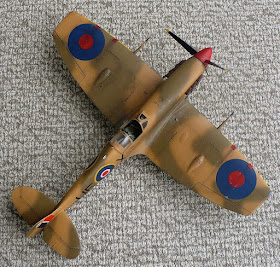




 Here are some images of Trumpeter's 1/32 scale Mikoyan Gurevich Mig 3. This aircraft served with the 12 Gaurds IAP Air Defense of Moscow 1942. From Wikipedia "
Here are some images of Trumpeter's 1/32 scale Mikoyan Gurevich Mig 3. This aircraft served with the 12 Gaurds IAP Air Defense of Moscow 1942. From Wikipedia "The Mikoyan-Gurevich MiG-3 (Russian: Микоян и Гуревич МиГ-3) was a Soviet fighter aircraft used during World War II. It was a development of the MiG-1 by the OKO (opytno-konstrooktorskiy otdel — Experimental Design Department) of Zavod (Factory) No. 1 to remedy problems that had been found during the MiG-1's development and operations. It replaced the MiG-1 on the production line at Factory No. 1 on 20 December 1940 and was built in large numbers during 1941 before Factory No. 1 was converted to build the Ilyushin Il-2.
On 22 June 1941 at the beginning of Operation Barbarossa, some 981 were in service with the VVS, the PVO and Naval Aviation. The MiG-3 was difficult to fly in peacetime and much more so in combat. It had been designed for high-altitude combat but combat over the Eastern Front was generally at lower altitudes where it was inferior to the German Messerschmitt Bf 109 as well as most modern Soviet fighters. It was also pressed into service as a fighter-bomber during the autumn of 1941 but it was equally unsuited for this. Over time the survivors were concentrated in the PVO, where its disadvantages mattered less, the last being withdrawn from service before the end of the war.
The MiG-3's top speed of 640 km/h (398 mph) at 7,200 metres (23,622 ft) was faster than the 615 km/h (382 mph) of the German Messerschmitt Bf 109F-2 in service at the beginning of 1941 and the British Supermarine Spitfire V's 603 km/h (375 mph). At lower altitudes the MiG's speed advantage disappeared as its maximum speed at sea level was only 505 km/h (314 mph) while the Bf 109F-2 could do 515 km/h (320 mph). Unfortunately for the MiG-3 and its pilots, aerial combat over the Eastern Front generally took place at low and medium altitudes where it had no speed advantage.
The MiG's loaded weight of 3,350 kg (7,385 lb) was greater than the Bf 109F-2's 2,979 kg (6,568 lb) and it was less maneuverable in the horizontal plane than the Bf 109 due to its higher wing loading. This lack of maneuverability was exacerbated by the MiG-3's poor climb performance, its instability at high speeds and its weak armament.
The MiG-3's standard armament was one 12.7 mm (0.50 in) UBS machine gun and two 7.62 mm (0.300 in) ShKAS machine guns. This was a rather light armament by international standards, for example most versions of the German Messerschmitt Bf 109 that it encountered were equipped with one 20 mm (0.79 in) autocannon and two 7.92 mm (0.312 in) machine guns. To remedy this problem 821 aircraft were built with one 12.7 mm UBK machine gun in a pod under each wing in mid-1941. This lowered its speed by about 20 km/h (12 mph) at all altitudes, which was unpopular with the pilots, some of whom removed the pods. One hundred aircraft were equipped with a pair of UBS machine guns in lieu of the ShKAS weapons. Another 215 aircraft also had just the UBS machine guns but were fitted to carry six RS-82 rockets. A total of 72 aircraft mounted a pair of 20 mm ShVAK cannon. A wide variety of armaments were experimented with by various units at the requests of their pilots or to make up shortages.


















































